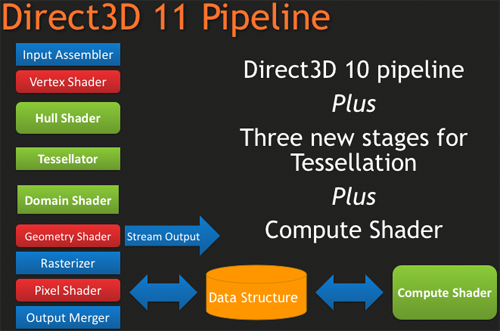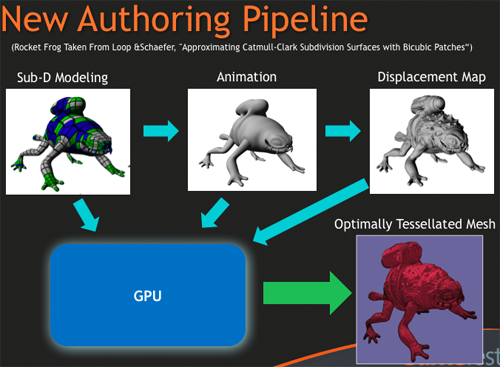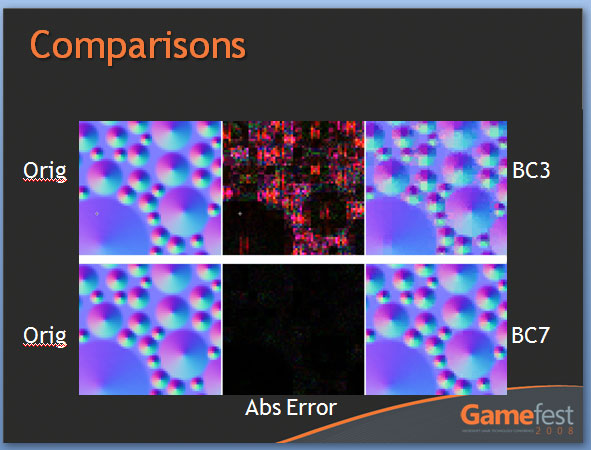AMD's Radeon HD 5870: Bringing About the Next Generation Of GPUs
by Ryan Smith on September 23, 2009 9:00 AM EST- Posted in
- GPUs
DirectX11 Redux
With the launch of the 5800 series, AMD is quite proud of the position they’re in. They have a DX11 card launching a month before DX11 is dropped on to consumers in the form of Win7, and the slower timing of NVIDIA means that AMD has had silicon ready far sooner. This puts AMD in the position of Cypress being the de facto hardware implementation of DX11, a situation that is helpful for the company in the long term as game development will need to begin on solely their hardware (and programmed against AMD’s advantages and quirks) until such a time that NVIDIA’s hardware is ready. This is not a position that AMD has enjoyed since 2002 with the Radeon 9700 and DirectX 9.0, as DirectX 10 was anchored by NVIDIA due in large part to AMD’s late hardware.
As we have already covered DirectX 11 in-depth with our first look at the standard nearly a year ago, this is going to be a recap of what DX11 is bringing to the table. If you’d like to get the entire inside story, please see our in-depth DirectX 11 article.
DirectX 11, as we have previously mentioned, is a pure superset of DirectX 10. Rather than being the massive overhaul of DirectX that DX10 was compared to DX9, DX11 builds off of DX10 without throwing away the old ways. The result of this is easy to see in the hardware of the 5870, where as features were added to the Direct3D pipeline, they were added to the RV770 pipeline in its transformation into Cypress.

New to the Direct3D pipeline for DirectX 11 is the tessellation system, which is divided up into 3 parts, and the Computer Shader. Starting at the very top of the tessellation stack, we have the Hull Shader. The Hull Shader is responsible for taking in patches and control points (tessellation directions), to prepare a piece of geometry to be tessellated.
Next up is the tesselator proper, which is a rather significant piece of fixed function hardware. The tesselator’s sole job is to take geometry and to break it up into more complex portions, in effect creating additional geometric detail from where there was none. As setting up geometry at the start of the graphics pipeline is comparatively expensive, this is a very cool hack to get more geometric detail out of an object without the need to fully deal with what amounts to “eye candy” polygons.
As the tesselator is not programmable, it simply tessellates whatever it is fed. This is what makes the Hull Shader so important, as it’s serves as the programmable input side of the tesselator.
Once the tesselator is done, it hands its work off to the Domain Shader, along with the Hull Shader handing off its original inputs to the Domain Shader too. The Domain Shader is responsible for any further manipulations of the tessellated data that need to be made such as applying displacement maps, before passing it along to other parts of the GPU.

The tesselator is very much AMD’s baby in DX11. They’ve been playing with tesselators as early as 2001, only for them to never gain traction on the PC. The tesselator has seen use in the Xbox 360 where the AMD-designed Xenos GPU has one (albeit much simpler than DX11’s), but when that same tesselator was brought over and put in the R600 and successive hardware, it was never used since it was not a part of the DirectX standard. Now that tessellation is finally part of that standard, we should expect to see it picked up and used by a large number of developers. For AMD, it’s vindication for all the work they’ve put into tessellation over the years.
The other big addition to the Direct3D pipeline is the Compute Shader, which allows for programs to access the hardware of a GPU and treat it like a regular data processor rather than a graphical rendering processor. The Compute Shader is open for use by games and non-games alike, although when it’s used outside of the Direct3D pipeline it’s usually referred to as DirectCompute rather than the Compute Shader.
For its use in games, the big thing AMD is pushing right now is Order Independent Transparency, which uses the Compute Shader to sort transparent textures in a single pass so that they are rendered in the correct order. This isn’t something that was previously impossible using other methods (e.g. pixel shaders), but using the Compute Shader is much faster.

Other features finding their way into Direct3D include some significant changes for textures, in the name of improving image quality. Texture sizes are being bumped up to 16K x 16K (that’s a 256MP texture) which for all practical purposes means that textures can be of an unlimited size given that you’ll run out of video memory before being able to utilize such a large texture.
The other change to textures is the addition of two new texture compression schemes, BC6H and BC7. These new texture compression schemes are another one of AMD’s pet projects, as they are the ones to develop them and push for their inclusion in DX11. BC6H is the first texture compression method dedicated for use in compressing HDR textures, which previously compressed very poorly using even less-lossy schemes like BC3/DXT5. It can compress textures at a lossy 6:1 ratio. Meanwhile BC7 is for use with regular textures, and is billed as a replacement for BC3/DXT5. It has the same 3:1 compression ratio for RGB textures.
We’re actually rather excited about these new texture compression schemes, as better ways to compress textures directly leads to better texture quality. Compressing HDR textures allows for larger/better textures due to the space saved, and using BC7 in place of BC3 is an outright quality improvement in the same amount of space, given an appropriate texture. Better compression and tessellation stand to be the biggest benefactors towards improving the base image quality of games by leading to better textures and better geometry.
We had been hoping to supply some examples of these new texture compression methods in action with real textures, but we have not been able to secure the necessary samples in time. In the meantime we have Microsoft’s examples from GameFest 2008, which drive the point home well enough in spite of being synthetic.

Moving beyond the Direct3D pipeline, the next big feature coming in DirectX 11 is better support for multithreading. By allowing multiple threads to simultaneously create resources, manage states, and issue draw commands, it will no longer be necessary to have a single thread do all of this heavy lifting. As this is an optimization focused on better utilizing the CPU, it stands that graphics performance in GPU-limited situations stands to gain little. Rather this is going to help the CPU in CPU-limited situations better utilize the graphics hardware. Technically this feature does not require DX11 hardware support (it’s a high-level construct available for use with DX10/10.1 cards too) but it’s still a significant technology being introduced with DX11.
Last but not least, DX11 is bringing with it High Level Shader Language 5.0, which in turn is bringing several new instructions that are primarily focused on speeding up common tasks, and some new features that make it more C-like. Classes and interfaces will make an appearance here, which will make shader code development easier by allowing for easier segmentation of code. This will go hand-in-hand with dynamic shader linkage, which helps to clean up code by only linking in shader code suitable for the target device, taking the management of that task out of the hands of the coder.










327 Comments
View All Comments
ilnot1 - Wednesday, September 23, 2009 - link
In fact, going by the lowest Newegg prices, this is how the top setups would stack up today:5870 CF .......= $760
GTX 285 SLI .= $592
GTX 295 .......= $470
GTX 275 SLI .= $420
5870 ............= $380
4890 CF ........= $360
4870 X2 ........= $330
This would make the 4890 CF or the 275 SLI setups the best value. And yes I realize there will be availability issues and price adjustments over the next month or so.
DominionSeraph - Thursday, September 24, 2009 - link
you forgot:4870 CF: $260-280
and how about the $180 4850 CF, which is probably the best price/performance for sub-1920x1200 gaming. http://www.anandtech.com/video/showdoc.aspx?i=3517...">http://www.anandtech.com/video/showdoc.aspx?i=3517... You can even get 1GB versions for ~$190.
ilnot1 - Wednesday, September 23, 2009 - link
Another very good review, thanks.But piggy backing on what wicko said, I'm surprised you didn't include two 4890 in CF. Seeing as how you can get two 4890 for less than a 5870 (whenever they are actually available). $180 x 2 = $360 < $379. And this from Newegg, not some super special sale price.
http://www.newegg.com/Product/Product.aspx?Item=N8...">http://www.newegg.com/Product/Product.aspx?Item=N8...
Ryan Smith - Wednesday, September 23, 2009 - link
It's something we would have included if we had the cards. I don't have 2 4890s, and we couldn't get a second one in time.AnotherGuy - Wednesday, September 23, 2009 - link
as always anandtech roxnbjsl2000 - Wednesday, September 23, 2009 - link
Finally time to upgrade..SiliconDoc - Wednesday, September 23, 2009 - link
Not only all that, but when there were 13 big titles for PhysX and a hundred smaller ones, we were told here, "Meh", who needs it.Now, we have a papery and unavailable (egg)except by pre-order(tiger) 5870 launch, a not-existing 5850, with guess what ? NO DX11 games!
Oh wait, there is actually just ONE - see page 7 of review. LOL
---
Conclusion ?: " It looks like NO(err.. just one) DX11 games ready, so... it also looks like NVidia is launching at the right time, and ATI blew their dry unimpressive wad on a piece of paper porn. "
---
Gee no one crowing about the first DX11 card... imagine that...
Good thing , too, considering how 13 big or a hundred titles small of PhysX enhanced games was "nothing to change one's purchase decision over". At least Anand got addicted to Mirror's Edge with PhysX enabled before concluding in the article "meh" this PhysX thing is ok if you like this game, but who cares...
---
Now we have the DX11 pre DX11 games launch with a paper product, so crowing about it wouldn't be too fitting, huh.
monomer - Wednesday, September 23, 2009 - link
Why would a developer would release a DX11 game before DX11 is even available?SiliconDoc - Friday, September 25, 2009 - link
Why would a developer release a DX11 card before DX11 is even available ?(I suppose you'll have to unscrew your hate nvidia foil cap, and grind in the red spikes in it's place to answer that one.)
However, allow me, instead.
1.I have been running windows 7 32&64 for quite some time now, not sure why you haven't been.
2. Battleforge, an ATI promo game, as noted in the review, has released their DX11 patch, hence, with W7 from MSFT (the beta+ free trial good till March 1st 2010 or something like that) I believe any gamer has had a reasonable chance to preview DX11.
---
So anyway...
cactusdog - Friday, September 25, 2009 - link
Ya , ATI has done it again. Excellent performance for a fair price. If Nvidia released this exact card it would be $150-$200 more expensive.LOL, Nvidia sales are gonna be slow for a while.